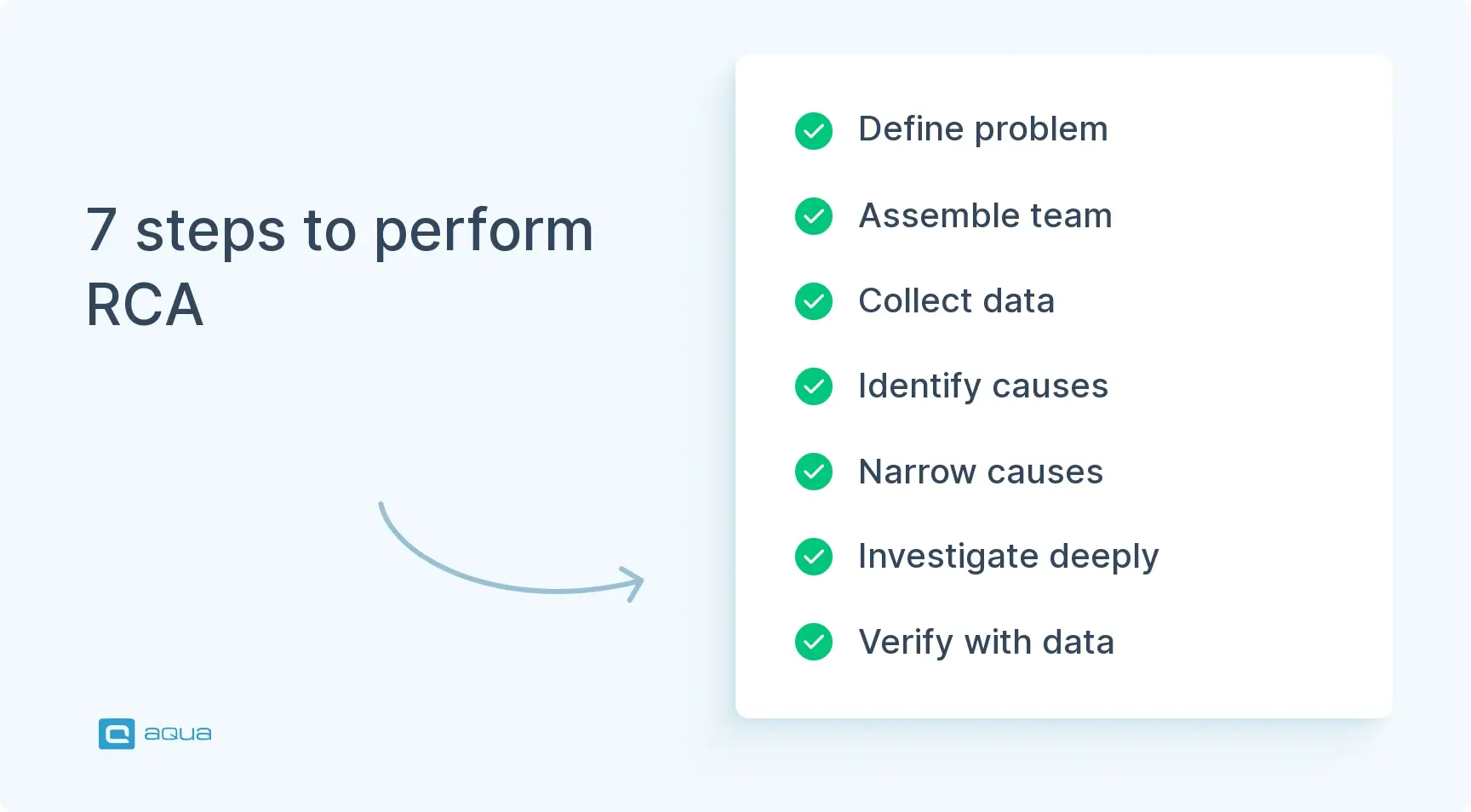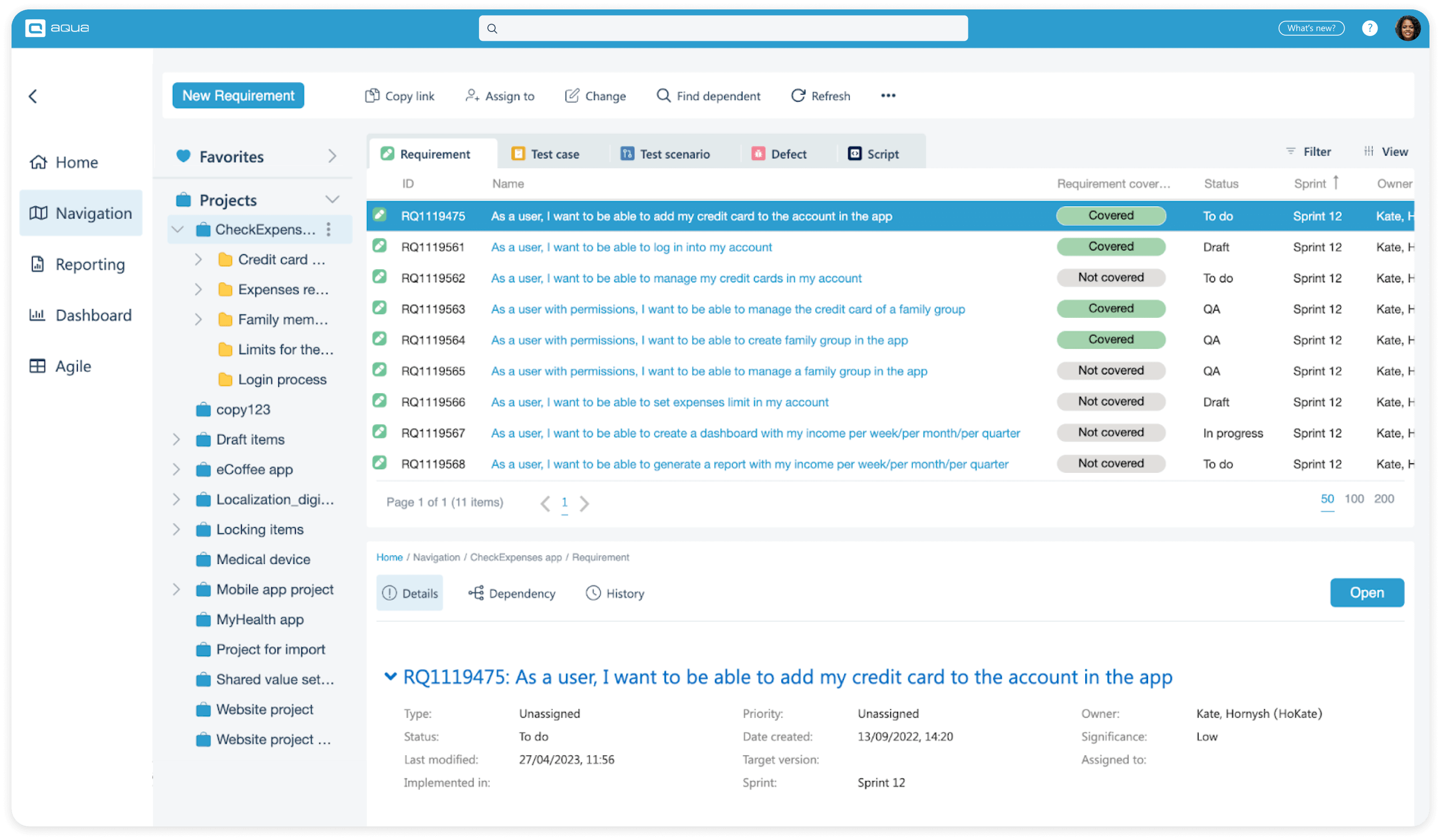This is the foundation of Root Cause Analysis (RCA) in software testing — a strategic approach that goes beyond addressing symptoms to unveil the underlying triggers of problems. Whether you’re dealing with performance bottlenecks, annoying system crashes, or mysterious data inconsistencies, RCA is a guiding compass to navigate the maze of software defects. Let’s dig deeper.
What is Root Cause Analysis?
Let’s start with the meaning of RCA, shall we? The root cause analysis process is a systematic and structured problem-solving methodology to identify the causal factors or underlying causes of issues, incidents, or problems within a system, process, or situation. RCA aims to go beyond addressing surface-level symptoms and uncover the problem’s root or potential causes that, if addressed, can prevent the recurrence of the same or similar issues in the future.
Root cause analysis steps are used across various fields, including engineering, manufacturing, healthcare, quality management, project management, and software development. It aims to provide a deeper understanding of problems by analysing the relationships between causes and effects and by identifying factors that contribute to the occurrence of an issue.
“Maybe you are searching among the branches for what only appears in the roots.”
Top 11 benefits of RCA
Root cause analysis methods (RCA) offer many benefits, including the following:
- Effective problem solving: RCA helps you to move beyond quick fixes and address the underlying causes of problems, leading to more effective and sustainable solutions.
- Risk reduction: Carrying out root cause analysis reduces the likelihood of serious incidents or failures, minimising risks to safety, reputation, and compliance.
- Enhanced decision-making: An effective root cause analysis process provides valuable insights that guide informed decision-making, allowing you to allocate resources more effectively and prioritise actions based on a deeper understanding of issues.
- Improved customer satisfaction: RCA-driven improvements lead to higher-quality products and services, increasing the odds of meeting customer expectations.
- Regulatory compliance: RCA helps ensure compliance in regulated industries by addressing issues that could lead to non-compliance or regulatory violations.
- Enhanced process efficiency: By analysing the root causes of inefficiencies or bottlenecks, RCA helps streamline processes, eliminate waste, and optimise workflows.
- Continuous improvement: RCA fosters a culture of continuous improvement, where you learn from mistakes, adapt processes, and seek innovative solutions.
- Better resource usage: You can direct your resources toward addressing true causes rather than repeatedly addressing symptoms, optimising resource allocation and reducing unnecessary expenditures.
- Increased accountability: RCA encourages a comprehensive examination of factors contributing to problems, promoting personal accountability within the team.
- Enhanced communication: Collaborative RCA encourage open communication among departments and stakeholders, fostering a holistic understanding of complex issues.
- Knowledge sharing: You can share the lessons from RCA across the organisation, promoting knowledge dissemination and skill development.

When to perform Root Cause Analysis?
You should perform root cause analysis (RCA) whenever you see an unexpected or undesirable outcome in a process, product, or service. This includes human error, incidents, failures, defects, accidents, or any situation where identifying and addressing the underlying cause is crucial. These are the examples:
- Incidents or accidents: When an unexpected event occurs, such as a safety incident in a workplace or a software system outage, the RCA plan can help determine the underlying causes to prevent similar incidents in the future.
- Failures or defects: When a product or service fails to meet quality standards or customer expectations, RCA can identify the contributing factors to the failure, allowing organisations to implement solutions and prevent recurrence.
- Errors or mistakes: When errors occur in processes or procedures, RCA can uncover the reasons behind the errors, such as inadequate training, unclear instructions, or systemic issues, and help implement measures to prevent future errors.
You’ll get far better results from your root cause analysis when you ditch the blame game entirely. This way, teams clam up when they think fingers will be pointed, but they’ll dig deep into messy details when it’s safe to do so.
Here is why it is essential:
- Prevention of recurrence: By identifying and addressing the causal factors leading to problems, RCA helps prevent similar issues from happening again in the future.
- CI (continuous improvement): The benefit of effective root cause analysis is that it promotes a culture of continuous improvement by identifying areas for enhancement in processes, systems, and behaviours.
- Resource optimisation: By focusing resources on implementing primary cause analysis techniques rather than treating symptoms, you can optimise your efforts and investments.
- Stakeholder confidence: Demonstrating a commitment to identifying and addressing underlying issues through RCA can enhance stakeholder confidence in the organisation’s ability to deliver high-quality products and services.
Root Cause Analysis for Successes: Not Just for Failures
Most teams only break out Root Cause Analysis when things blow up. But here’s the thing – you should absolutely be running RCA on your wins too. That surprise spike in user adoption? The release that went off without a hitch? The process improvement that nearly doubled efficiency? These deserve the same analytical attention as your failures.
Document what happened during successful outcomes within 48 hours while details are fresh. Interview team members about what felt different or unexpected. You’ll often discover hidden factors – maybe a small configuration tweak had an outsized impact, or informal communication patterns actually improved coordination. The goal is reverse-engineering excellence so you can repeat it deliberately rather than hoping lightning strikes twice.
“We use root cause analysis all the time. We request 5why reports from suppliers if there are issues with product. And we use FMEA and DMFEA frequently.”
Best techniques and methods for Root Cause Analysis
Here’s the thing about root cause analysis: you’ll need multiple tools in your toolkit, not just one go-to method. Complex problems rarely have single causes, so throw in 2-3 different techniques and get your team involved.
Here are the main ones you should use:
- Ishikawa (fishbone) diagram: Use this to brainstorm and categorise potential causes of software defects. Categories might include requirements, design, code, environment, and testing processes.
- 5 whys: Apply this technique to investigate the underlying reasons behind software defects. For instance, repeatedly asking “why” can reveal whether a lack of understanding of requirements or inadequate testing procedures caused the defect.
- Pareto analysis: Prioritise the most critical defects using Pareto Analysis. Focus on addressing the defects that have the most significant impact on software functionality and user experience. Risk-based testing is a practical extension of this principle.
- Failure mode and effects analysis (FMEA): Use FMEA to assess potential failure modes and their effects on software quality. This will help you prioritise testing efforts and develop strategies to mitigate high-risk failure modes.
- Change analysis: Analyse changes to the software code or configuration before and after introducing defects. This can help identify whether specific changes led to the emergence of defects.
- DMAIC (Define, Measure, Analyse, Improve, Control): Apply DMAIC to improve testing processes. Define testing goals, measure defects and testing effectiveness, analyse root causes, implement improvements, and establish controls to prevent future defects.
Using AI for Accelerated Root Cause Analysis
Root Cause Analysis is getting a serious upgrade thanks to AI integration in testing workflows. These smart tools can churn through millions of log lines and spot patterns way faster than any human could – automatically flagging anomalies and probable failure sources before you’ve even finished your coffee.
But AI-assisted bug triage doesn’t just find issues faster, it can identify duplicate problems, create digestible summaries of complex bug reports, and suggest likely root cause categories based on what’s happened before. Some test management platforms now throw in predictive analytics that highlight which modules are most likely to break next – letting teams focus their testing energy where it’ll actually matter. Companies using these AI capabilities report investigation times dropping by nearly half. You need to start by implementing AI log analysis on your most problematic modules first, rather than trying to deploy across everything at once. You’ll see faster wins and build confidence in the technology. The result is a streamlined RCA processes that actually help you prevent problems instead of just reacting to them.
As you strive to master root cause analysis, aqua cloud stands as your trusted partner. Our advanced test management solution provides the perfect environment for thorough RCA in software testing. aqua cloud offers intuitive features, insightful analytics, and seamless collaboration, empowering your team to dissect issues, explore causes, and implement effective solutions within a unified platform. Say goodbye to scattered data and embrace a holistic approach to problem-solving. aqua cloud is the first tool to bring the power of AI to the software testing industry. It embodies German quality, ensuring reliability and precision. With over 10 years of market leadership, aqua cloud is taking away the pain of testing.
Everything you need to know about testing with AI is just a click away
14 steps of performing root cause analysis
If you’ve been wondering how to do Root Cause Analysis, here is your step-by-step guide:
- Define the problem: Clearly articulate the problem that needs analysis. Gathering data, facts, and information about the issue for a thorough understanding.
- Assemble a team: Form a multidisciplinary team with diverse expertise and perspectives relevant to the problem, enhancing the depth of analysis and promoting comprehensive problem-solving.
- Collect data: Gather relevant data, documents, and reports associated with the problem, including incident reports, logs, metrics, and historical information.
- Identify possible causes: Brainstorm and list potential contributing factors or primary causes of the problem. Encourage open and independent thinking within the team to generate a comprehensive list.
- Narrow down causes: Analyse the list of potential causes and use techniques like the 5 Whys, fishbone diagrams, or Pareto analysis to carry out corrective action toward these root causes.
- Investigate root causes: Thoroughly monitor each potential root cause by gathering additional data, conducting interviews, and using analytical tools. Understand the sequence of events and interactions that led to the problem.
- Verify root causes: Validate the identified root causes through evidence and data. Ensure that facts and not assumptions support the causes.
- Create solutions: Brainstorm and propose feasible solutions to address the root causes. Each solution should directly target a specific root cause.
- Implement solutions: Put the proposed solutions into action. Implement process changes, system modifications, training programs, or other necessary actions.
- Monitor and evaluate: Continuously track the implemented solutions to assess their effectiveness. Monitor relevant metrics and indicators to ensure that the problem does not resurface.
- Prevent reoccurrence: Implement preventive measures to ensure the problem does not resurface, like process improvements, policy changes, or ongoing monitoring.
- Document findings: Record all the findings, analysis, and actions taken throughout the RCA. This documentation serves as a valuable resource for future reference and learning.
- Share knowledge: Share the RCA results throughout the team, including insights, lessons learned, and recommendations to promote learning and prevent similar problems in the future.
- Review and learn: Conduct a post-RCA review to evaluate the effectiveness of your analysis and solutions. Identify opportunities for further improvement in the RCA itself.

14 tips for successful RCA
A successful Root Cause Analysis (RCA) requires careful planning and execution. Here are some valuable tips on performing effective root cause analysis:
- Define clear objectives: Clearly outline the goals and objectives of the RCA. Understand what specific problem you are trying to address and what outcomes you hope to achieve.
- Establish a safe environment: Create an environment where team members feel comfortable sharing their insights, even if they involve mistakes or failures. Emphasise that the goal is to identify causes, not assign blame.
- Thoroughly gather data: Collect relevant data, documents, and reports related to the problem. Analyse both quantitative and qualitative information to gain a comprehensive understanding.
- Use structured techniques: Employ proven RCA techniques like fishbone diagrams, 5 Whys, or fault tree analysis. These methods provide structured frameworks to guide your analysis.
- Question assumptions: Challenge assumptions and encourage critical thinking. Avoid jumping to conclusions without sufficient evidence.
- Focus on root causes: Distinguish between specific symptoms and root causes. Addressing symptoms may provide temporary relief, but focusing on root causes leads to long-lasting solutions.
- Dig deep: Go beyond immediate causes and explore deeper factors contributing to the problem. Investigate underlying systems, processes, procedures, communication breakdowns, and systemic issues.
- Encourage open communication: Foster open and honest communication among team members. Encourage active listening and the sharing of different viewpoints.
- Verify findings: Ensure that your findings are well-supported by evidence and data. Avoid assumptions and conjecture.
- Prioritise solutions: Develop solutions that target the identified root causes. Prioritise these solutions based on their potential impact and feasibility.
- Test solutions: Before implementing changes, consider testing solutions on a small scale to assess their effectiveness. This can help avoid unintended consequences.
- Document the process: Maintain a detailed record of your RCA, including data collected, analysis performed, findings, and implemented solutions. This documentation is a valuable reference.
- Promote continuous improvement: Treat RCA as a learning opportunity. Carry out corrective actions Analyse the effectiveness of implemented solutions and continuously refine your RCA.
- Share knowledge: Distribute the results of the RCA throughout the organisation. Sharing insights and lessons learned helps prevent similar issues in the future.
aqua cloud — your solution for effective RCA
As we plunge deeper into quality assurance, the pursuit of excellence often leads us into areas where innovative root cause analysis tools and methodologies intersect to create new paths of understanding. RCA, as we’ve explored, is an effective solution to unravelling the intricate web of factors underlying cause or issues, ensuring immediate solutions and sustained quality enhancement. With its sophisticated features, aqua opens avenues for a more streamlined and insightful RCA process.
1. Relationships unveiled: At the heart of RCA, you should be able to identify causal factors and intricate relationships between various elements. aqua’s interconnectedness allows you to trace the threads that weave through different items – be it requirements, test cases, or defects. This view provides a holistic understanding of how different components interact, aiding in identifying the root cause.

2. KPI alerts and dashboards: aqua’s KPI alerts and dashboards help you guard against anomalies and deviations from the norm. When an issue arises, these alerts guide you towards areas that demand attention. You can pinpoint potential root causes and initiate a targeted investigation by correlating KPI alerts with the RCA process.

3. Tracking bug progression: One of aqua’s standout features is its ability to track bugs marked as fixed since your last test execution. This dynamic view allows you to assess the impact of fixes and identify if they have inadvertently triggered new issues or altered the behaviour of other components. This “butterfly effect” analysis is a crucial facet of RCA, revealing causal relationships that might otherwise remain hidden.

4. Full traceability and item history: aqua’s commitment to comprehensive traceability ensures a clear historical context for every item in your QA process. This invaluable feature empowers you to trace the evolution of a component, understanding how changes and modifications might have contributed to the issue at hand. Armed with this historical perspective, your RCA gains depth and accuracy.

Incorporating aqua into your RCA process isn’t just about leveraging a tool — it’s about embracing a mindset. Much like RCA, aqua encourages you to go beyond the surface, question assumptions, and unearth the subtle interplays that define software quality.
Conclusion
In this article, we’ve explored the intricacies of RCA, delving into its systematic approach to uncovering the elusive factors that lie at the heart of issues. From the initial problem identification to implementing preventive measures, RCA offers a roadmap that resolves immediate concerns and paves the way for sustained quality improvement.
Remember, RCA is not just a standalone process; it’s a philosophy that encourages you to question assumptions, challenge conventions, and continuously seek more profound understanding. With a multidisciplinary team, structured techniques, and a commitment to learning from every challenge, RCA becomes a powerful tool that transforms setbacks into stepping stones toward excellence.
Do your Root Cause Analysis with an AI-powered tool


















